Note: This website was automatically translated, so some terms or nuances may not be completely accurate.
Is "Scheduled Mindset" Holding Back Japanese Travel? What Defines Today's Travel Mindset?
Dentsu Inc. Desire Design (DDD) is an organization that develops solutions and disseminates information based on the relationship between consumption and desire.
Starting with the 21st installment, we analyze DDD's "Heart-Moving Consumption Survey," sharing insights and findings derived from the survey results.
This time, based on the results of the 10th survey conducted in May 2025, DDD's Yasuaki Matsumoto interprets insights related to Japanese people's "travel."
Why the Decline? The Number of Japanese Traveling Overseas
In recent years, we frequently hear the topic of "Japanese people not traveling overseas." This is not merely a matter of perception; the passport acquisition rate among Japanese citizens in 2024 was 16.8% (Source: Travel Voice ), compared to the United States at 36% and Germany at 41% .
Furthermore, the number of outbound travelers in 2024 was approximately 13.01 million, with an outbound travel rate of 10.5% (Source: Travel Voice ), which is also significantly lower than other countries. While the recovery of outbound travelers, which plummeted due to COVID-19 in 2020, has been slow, there is also the aspect that overseas travel continues to grow at an even faster pace.
Why don't Japanese people travel abroad, or why have they stopped?
Common reasons cited include rising travel costs like lodging and dining expenses, an increase in generations with limited travel experience due to the pandemic, and the loss of appeal for overseas travel as information acquisition has become virtual.
This article examines the results of DDD's "Heart-Moving Consumption Survey" to decipher the current "travel mindset" (attitudes toward travel) among Japanese people and explore ways to halt the decline in Japanese travel.
Do Japanese consumers "dislike" travel?
The Heart-Moving Consumption Survey collects open-ended comments on "recent memorable consumption experiences" in each survey. Among these responses, 5.5% mention "travel/sightseeing," ranking 7th overall.
Among teens, it was almost nonexistent for both genders. For men in their 20s, it ranked 5th, while for women in the same age group, it ranked 14th. For all subsequent age groups, it consistently ranked around 10th place. Among various consumption experiences, "travel/sightseeing" can be said to rank relatively high (Figure 1).
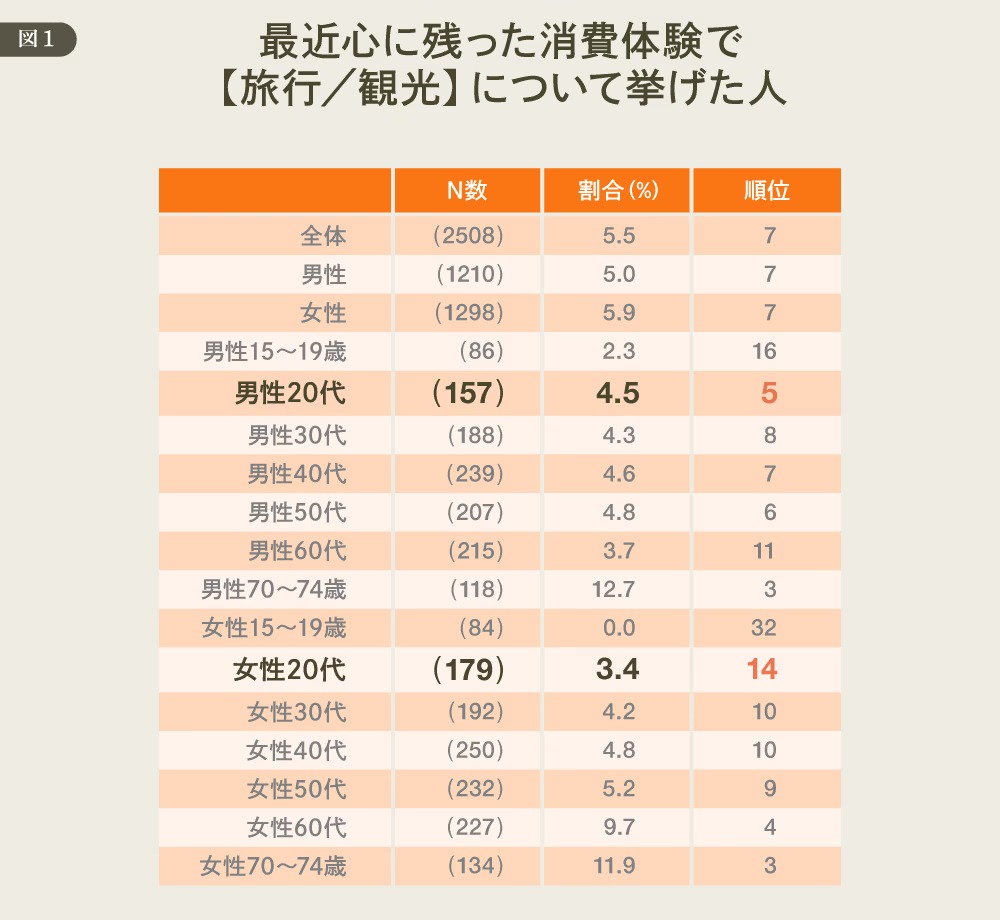
Furthermore, looking at responses to the question "Please tell us what you are usually interested in or care about," "Travel/Sightseeing" ranked 1st out of 46 items. Again, while slightly lower among teens of both genders, it consistently ranked within the top 3 for all other age groups (Chart 2).
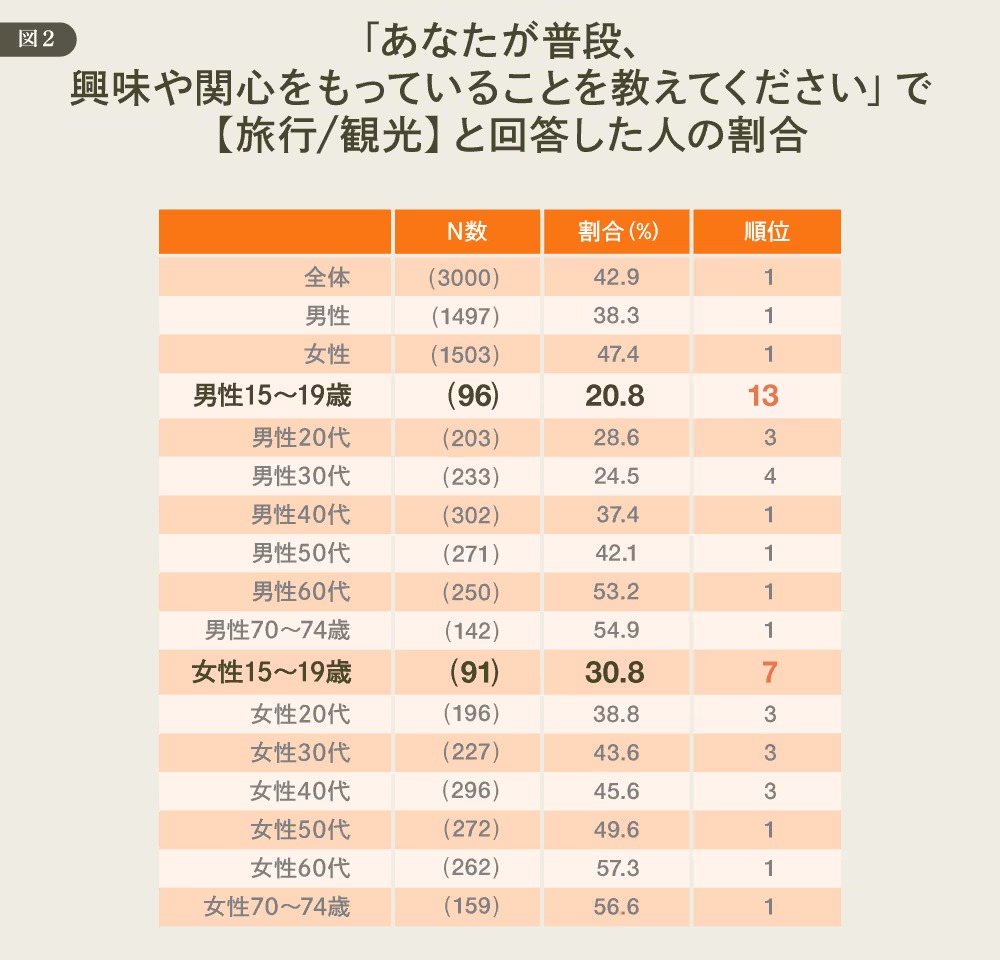
While teens show lower interest in travel, those in their 20s and older remain quite interested. For younger people, their interests are more dispersed, which may relatively diminish travel's standing.
Family households feel a stronger financial burden from travel. How Consumers Perceive "Travel"
The survey on values that influence consumption also asked about attitudes toward travel. Let's examine the results.
Regarding the statement "I think travel has become something only for the wealthy," 54.9% of all men and 59.7% of all women answered "I agree." Looking at it by age group, the tendency is particularly high among those in their 40s and 50s for both men and women (Figure 3). In other words, this suggests that the family generation feels a significant financial burden regarding travel.
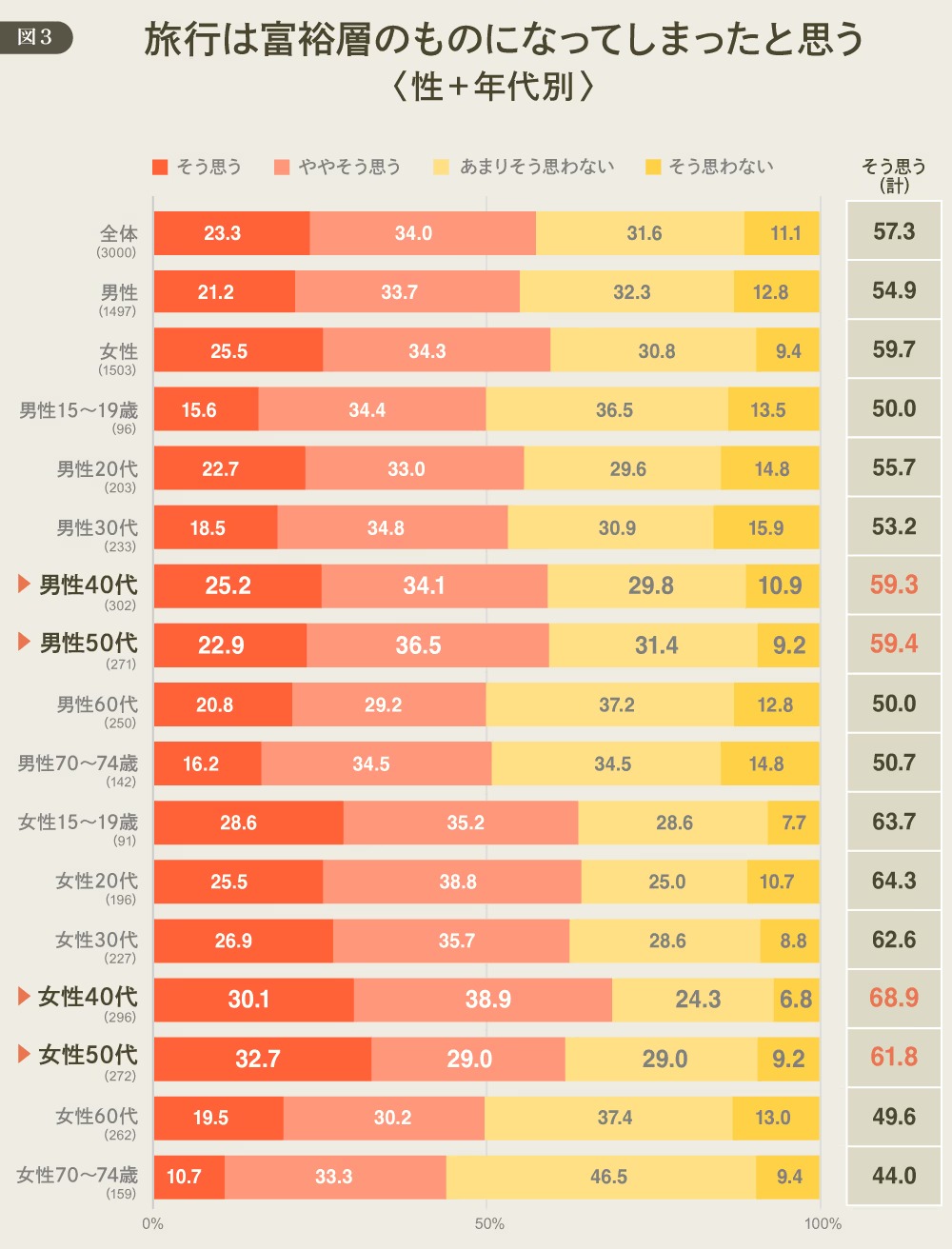
On the other hand, 54.1% of all men and 51.8% of all women answered "agree" to the question "I want to travel at least once a year, even if it means stretching my budget." This sentiment is stronger among younger respondents in their teens and twenties. Considering this alongside the previous results, while younger generations show less overall interest in travel compared to other activities, their desire to actually go on trips appears stronger than in other age groups (Figure 4).
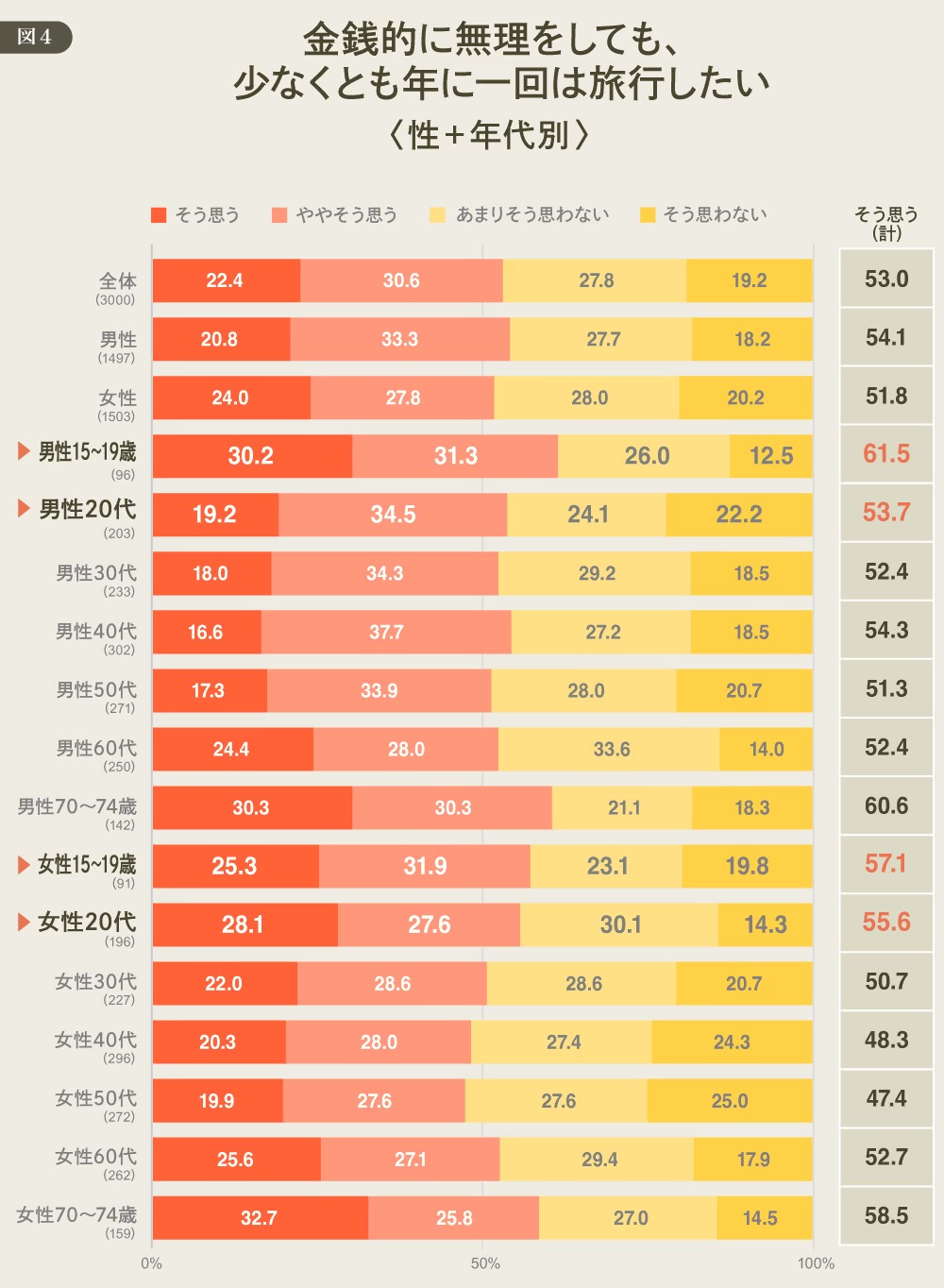
"Luxury Seekers"? Or "Long-Term Relaxation Seekers"? What Today's Consumers Seek in Travel
Now let's examine attitudes toward how people travel.
When asked whether they lean more toward "A: I want a luxurious trip, even if it's short" or "B: I want a longer trip, even if it means saving money," the overall trend favored "A: I want a luxurious trip, even if it's short." However, men showed a slightly higher tendency toward "B: I want a longer trip, even if it means saving money" (Figure 5).
Additionally, while not shown in the graph, women also tend to feel more strongly that it would be a waste not to try local specialties or visit famous sites and scenic spots when traveling. This result suggests women have a stronger desire to pack their trips with various activities and experiences.
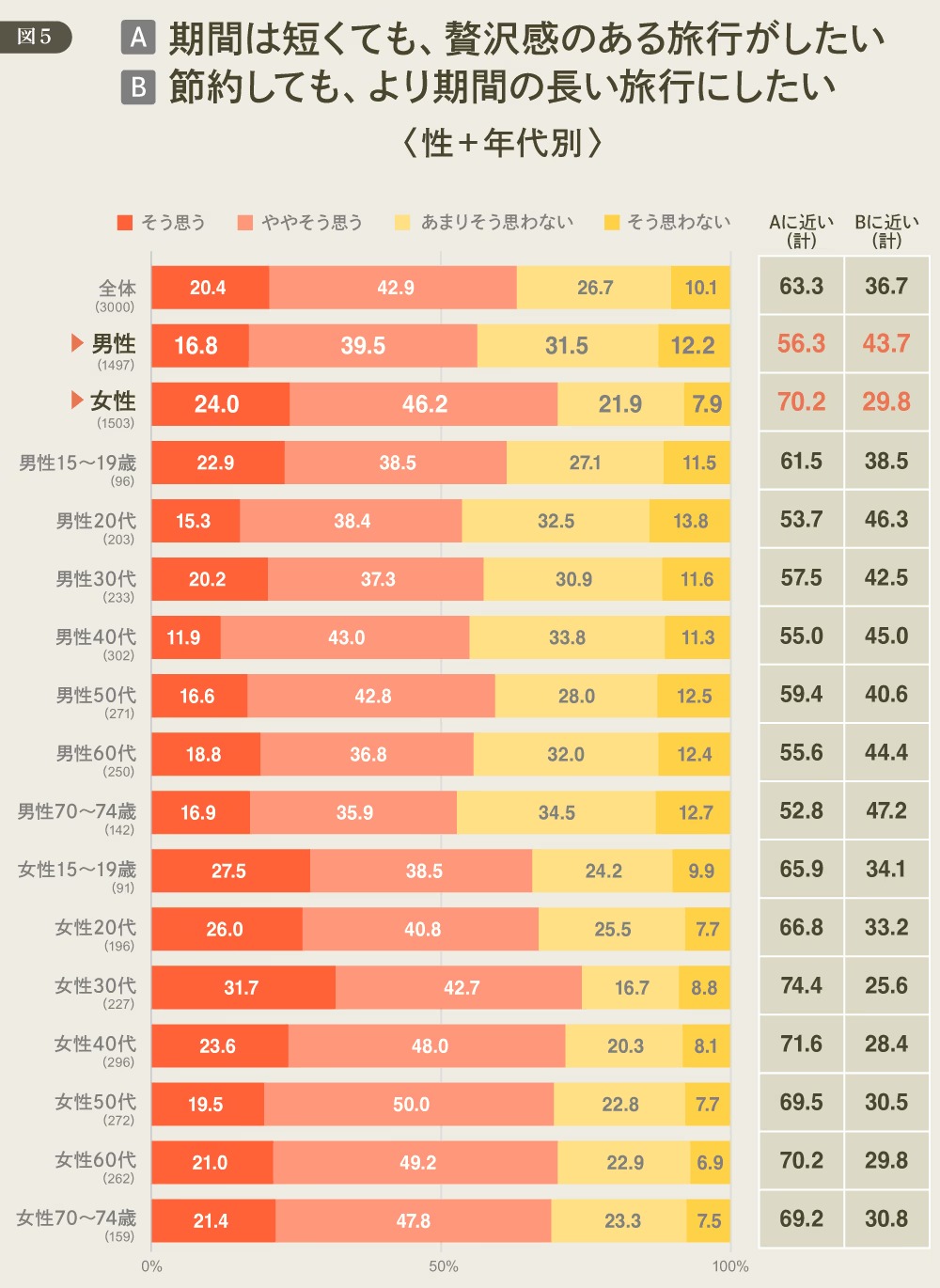
Looking at the above data, women generally tend to seek "luxurious trips where they can fully enjoy both food and sightseeing in a short period." Examining women's responses about travel in the "recent memorable consumption experiences" section of the actual consumption survey reveals many descriptions of such luxurious trips:
Yufuin hot spring inn: "It was a luxurious trip away from daily life, staying at a long-dreamed-of inn I'd always wanted to visit. I experienced the satisfaction I imagined." (Woman in her 70s)
A hotel stay in Tokyo: "We chose this as our last chance for a relaxed time together as a couple before having children. The hotel staff's service was incredibly good, making it a memorable experience." (Woman in her 30s)
Theme park package with lodging: "I wanted to experience that sense of excitement, of being somewhere extraordinary." (Woman in her 20s)
Package tour: "I wanted to escape daily life and enjoy hot springs and gourmet food." (Woman in her 60s)
In contrast, men's responses often focused on specific goals rather than overall travel expectations.
Charter fishing boat: "I want to catch my target fish using my own fishing style." (Male, 60s)
Nagara River Railway Free Pass: "I wanted to feel the excitement of visiting a region for the first time." (Male, 20s)
Snowy Great Valley sightseeing bus: "I planned the trip because I wanted to see that scenery at least once" (Male, 50s)
Both women's luxury-oriented travel preferences and men's purpose-driven travel preferences require financial and time flexibility to easily achieve. But is that the only reason for the decline in travel?
The "scheduling mindset" of Japanese people influencing travel attitudes
Here, I'd like to focus on one aspect of the values section in the consumption survey that captures the heart.
Looking at the items "[A] I tend to plan my day's schedule thoroughly in advance" (hereafter referred to as the "schedule-adherent group") and "[B] I prefer to decide my day's schedule based on my mood that day" (hereafter referred to as the "impulsive group"), overall, the [A] schedule-adherent group tends to be slightly larger (Figure 6).
However, the tendency for the [B] Whimsical Group to be larger is stronger among younger age groups. Specifically, among males in their teens and twenties and females in their teens, the [B] Whimsical Group outnumbers the [A] Schedule-Adherence Group (Figure 6). Furthermore, comparing the age composition of the [A] Schedule-Adhering Group and the [B] Whimsical Group, the [A] Schedule-Adhering Group leans slightly toward seniors, while the [B] Whimsical Group leans slightly toward younger age groups (Figure 7).
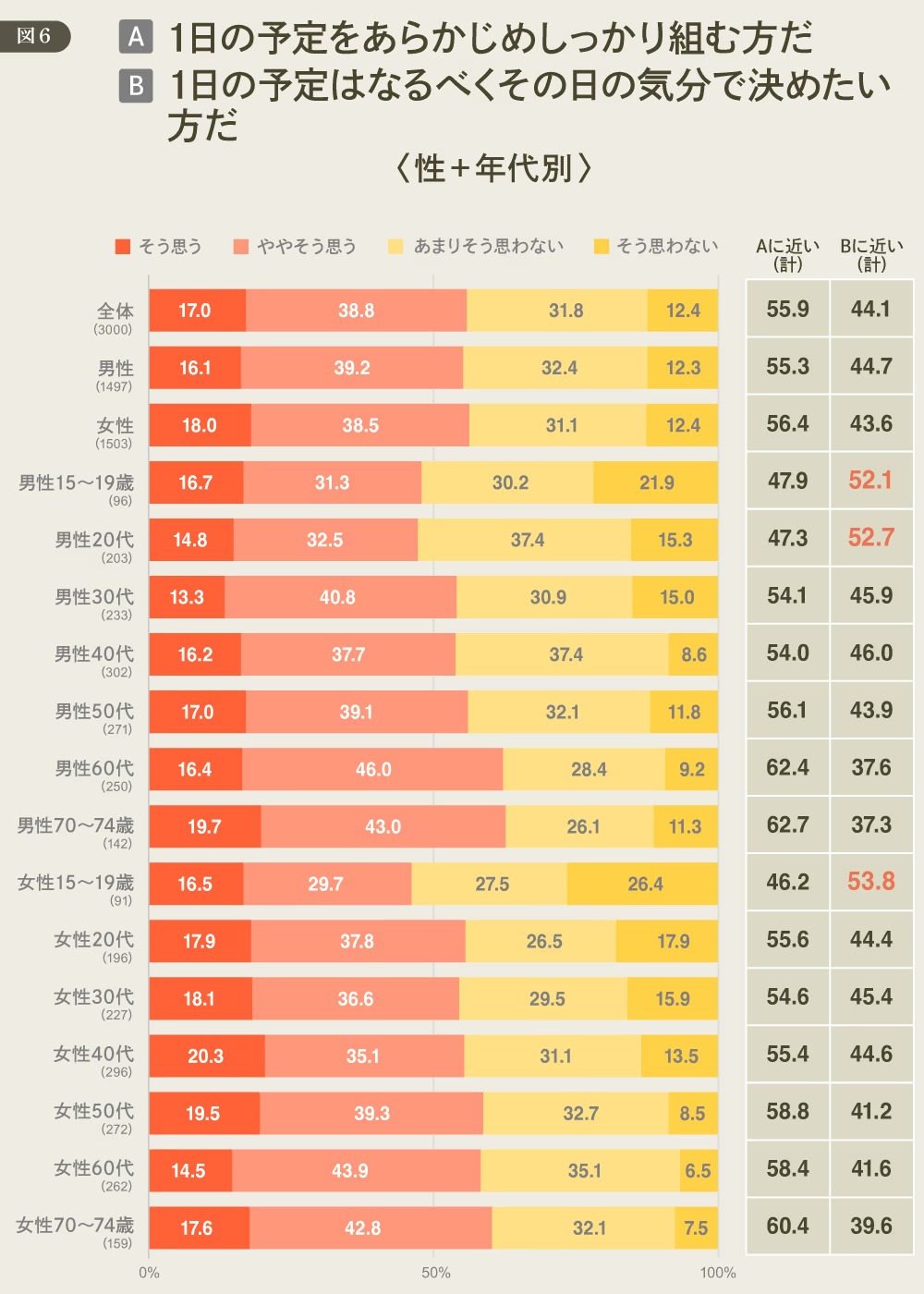
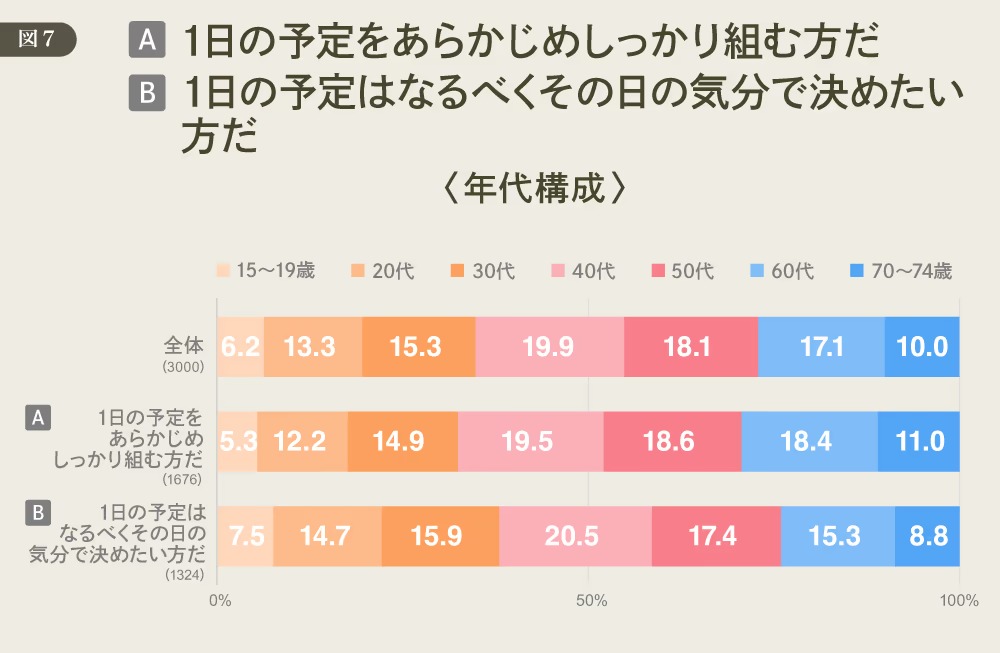
Let's compare these [A] Scheduled Travelers and [B] Impulsive Travelers using the travel awareness items we examined earlier.
Regarding the statement "I think travel has become something only for the wealthy," 59.0% of the [A] Scheduled Travelers agreed, while only 55.2% of the [B] Impulsive Travelers agreed, showing a slightly lower rate. Similarly, for "I want to travel at least once a year, even if it means stretching my budget," 57.7% of the [A] Scheduled Travelers group agreed, while only 47.0% of the [B] Impulsive Travelers group agreed.
Regarding travel preferences, 66.1% of the [A] Scheduled Travelers group answered "I want a luxurious trip, even if it's short," while only 59.7% of the [B] Impulsive Travelers group agreed. Conversely, 40.3% of the [B] group answered "I want a longer trip, even if it means saving money" (Figure 8).

Overall, while the [A] Scheduled Travelers align closely with the general travel mindset seen earlier, the [B] Impulsive Travelers, while not necessarily viewing travel as exclusively for the wealthy, demonstrate a fundamentally lower level of interest.
For the [B] Impulsive Group, who decide plans based on their mood that day, the various arrangements and preparations involved in travel may present a high hurdle, potentially dampening their interest. Furthermore, the [A] Scheduled Group, while wanting to travel at least once a year, likely lack the financial or time flexibility to do so.
The key to revitalizing Japanese travel enthusiasm lies in lowering the barriers to "travel preparation."
While many choose free-plan or independent travel, these often require significant preparation effort. Some may view travel preparations—booking hotels and transportation, planning itineraries, purchasing travel gear—as part of the journey's charm. However, for the [B] Impulsive Group, these very preparations could be creating barriers to travel.
Looking at the "recent memorable consumption experiences" in the survey on emotionally driven consumption, many respondents mention not just scenic spots or tourist attractions, but also tour names and hotel names. This suggests that memorable trips aren't limited to those where individuals personally select destinations and plan itineraries; trips centered around participating in tours organized by travel agencies or hotel stays also leave a strong impression.
Furthermore, recent travel trends like all-inclusive hotels and cruises require minimal preparation effort once the schedule is set.
In conclusion, package tours, which have become more sophisticated and senior-friendly in recent years, also seem to present opportunities as products appealing to a broader range of age groups. From the perspective of travel preparation, hotels with well-equipped amenities or those offering substantial breakfasts also appear to present opportunities for this fickle segment.
DENTSU DESIRE DESIGN will continue to conduct deeper analysis on various consumer behaviors, including travel.
[Survey Overview]
10th "Heart-Moving Consumption Survey"
・Target Area: Nationwide, Japan
・Respondent Criteria: Men and women aged 15–74
・Sample Size: Total 3,000 samples (allocated according to population ratio across 7 age groups: 15-19, 20s-60s, 70-74, and 2 gender groups)
・Survey Method: Online survey
・Survey Period: Tuesday, May 13, 2025 – Friday, May 16, 2025
・Survey Sponsor: Dentsu Inc. DENTSU DESIRE DESIGN
・Survey Agency: Dentsu Macromill Insight, Inc.
The information published at this time is as follows.
Was this article helpful?
Newsletter registration is here
We select and publish important news every day
For inquiries about this article
Back Numbers
Author

Yasuaki Matsumoto
Dentsu Inc.
Second Integrated Solutions Bureau
Principal Researcher
After joining the company, I primarily worked in marketing-related departments, handling account planning for clients across various industries including food and beverages, alcoholic beverages, home appliances, insurance, and finance. Subsequently, in 2010, served as a principal researcher at Media Shakers' M1/F1 Research Institute, studying consumer psychology among those in their 20s and 30s. From 2013, worked at DENTSU SOKEN INC., handling consumer trend analysis and trending/notable products. Joined the Dentsu Future Forecasting Support Lab in 2017. [Specialized Fields] Consumer trends, consumption patterns, consumer insights



